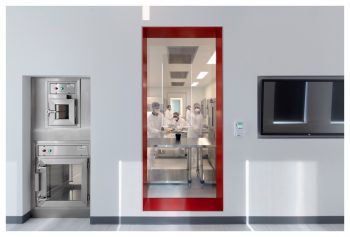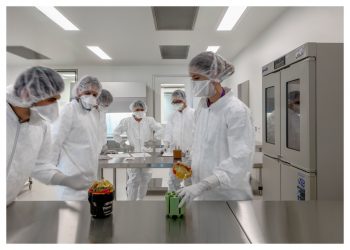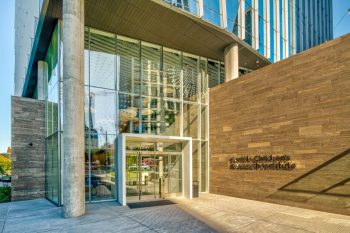
Recent breakthroughs in cell and gene therapy research within Seattle Children’s Research Division, which includes both Seattle Children’s Research Institute and Seattle Children’s Therapeutics, has contributed to the creation of new technologies, new companies and – researchers hope –will lead to a range of new treatments and cures for pediatric diseases down the line.
Cell and gene therapy has become an increasingly popular form of therapeutic treatment and research in recent years.
“It has really become a third pillar of therapeutic treatment behind small molecules and monoclonal antibodies – cell therapy is here to stay and it’s growing exponentially as more capabilities are developed,” said Dr. Brian Phillips, director of the Intellectual Property Core at Seattle Children’s, which aims to help Seattle Children’s researchers and clinicians commercialize their intellectual property.
Spin-off success
In the last few years, Seattle Children’s has spun-out and established industry-funded research collaborations with several new biotechnology start-up companies in the cell and gene therapy space. These industry-funded collaborations are a crucial step toward advancing pediatric medicine. Each of these new industry collaborations will help to provide new treatment options for children. Partnering with these biotech companies permits Seattle Children’s to accelerate research breakthroughs. Further, by accelerating the cost-intensive path to first-in-patient clinical trials, these relationships more rapidly allow the development of cell therapies specifically tailored to meet the unique needs of children.
In August 2020, GentiBio, Inc., a biotherapeutics company developing engineered regulatory T cells programmed to treat autoimmune, alloimmune, autoinflammatory, and allergic diseases, announced it had entered into an exclusive licensing partnership for a series of proprietary regulatory T cell engineering technologies, developed in part by Dr. David Rawlings, director of the Center for Immunity and Immunotherapies within Seattle Children’s Research Institute. Rawlings is also a scientific co-founder of GentiBio.
Importantly, in the last year and a half, these newly licensed gene editing technologies were further expanded within the Rawlings laboratory using funds supported by GentiBio. Based in significant part on these expanded studies, in August 2021, GentiBio received $157 million in Series A funding. This new funding was led by Matrix Capital Management, with participation by Avidity Partners, JDRF T1D Fund, seed investors OrbiMed, RA Capital Management, Novartis Venture Fund, and Seattle Children’s Research Institute. This support demonstrates the immense interest from investors in bringing T regulatory cell therapies to market for treatment of a broad array of immune diseases from autoimmune diseases, including for Type 1 diabetes, to solid organ transplant and autoinflammation.
Umoja Biopharma, which is building a cellular immunotherapy platform with a goal of re-engineering a patient’s immune system to target solid and hematological malignancies, was founded in 2019 based on research performed at Seattle Children’s and Purdue University.
Dr. Michael Jensen, vice president of Seattle Children’s Therapeutics and chief therapeutics officer, is also a co-founder of Umoja Biopharma. Seattle Children’s Therapeutics is a non-profit therapeutics development group, devoted to envisioning and testing next-generation cell and gene therapies for pediatric diseases so children have the medicines they deserve.
Umoja Biopharma is currently utilizing lab space at Seattle Children’s Research Institute’s Building Cure, which opened in 2019, through an incubation collaboration. Furthermore, Umoja recently entered into a funding agreement which will support Seattle Children’s Therapeutics in initiating a clinical trial using CAR-T therapy to treat relapsed/refractory osteogenic sarcoma.
“When Umoja Biopharma first was being conceived, they hadn’t yet received series A funding and needed space to begin their research. Seattle Children’s stepped in to provide them with space at our downtown campus to incubate the company. Fast forward to now, they’ve raised significant funding and their research is well underway,” said Phillips. “And while Seattle Children’s does not have a direct investment program we are investing in the capabilities in our research labs and incubation space – the intangibles that can come together to help entrepreneurs and venture capitalists visualize what would be a successful company.”
Umoja Biopharma recently received Series B funding of $210 million.
Most recently, in October 2020, Be Biopharma, a company that aims to engineer B cells to treat a variety of diseases, launched with $52 million Series A financing led by Atlas Venture and RA Capital Management and joined by Alta Partners, Takeda Ventures, Inc, and founding investor Longwood Fund.
The company is built on research done by Drs. David Rawlings and Richard James, principal investigators within the Center for Immunity and Immunotherapies. B cells play a central role in the immune system. When the body is confronted with an infection, they turn into plasma cells that release protective antibodies that both fight ongoing infections and prevent future ones. Be Biopharma has licensed Seattle Children’s technology that enables these cells to durably produce therapeutic proteins in patients across multiple therapeutic areas.
“Seattle Children’s Research Institute has made significant headway in uncovering the mechanisms of B cells, and Be Biopharma has licensed our proprietary platform to work toward creating a new category of cell therapy that may eliminate significant hurdles, such as the need for regular injections or use of toxic chemotherapy associated with other therapies,” said James. “There are an enormous number of potential applications of this technology spanning from replacement of missing proteins in genetic diseases to cancer therapy.”
Drs. Rawlings and James are co-founders of the company.
In terms of next steps, Rawlings says the company is building methods to produce B cell therapies at large scale and development of the first clinical product, which will target a rare enzyme deficiency. In parallel, there is ongoing research being done at Seattle Children’s to improve the therapy, including studies designed to allow therapeutic cells from one person to be used to treat genetically unrelated patients.
“It’s important to emphasize that Seattle Children’s technologies are not simply in-licensed by these start-up companies, but the technologies are the intellectual property foundation of these spin-outs,” said Tandi Collisson, a senior business development manager in Seattle Children’s Intellectual Property Core. “It speaks to how important innovation is at Seattle Children’s – that Seattle Children’s innovation has gone directly into creating several companies.”
Collisson also underscored that the relationship between these companies and Seattle Children’s Research Institute will extend beyond the licensing deals.
Continued involvement in therapeutic development
“Our goal has been to maximize the opportunities for Seattle Children’s from our own innovations so that Seattle Children’s will be an integral part of bringing new treatments and therapies to children around the world. We have negotiated the potential to be a part of many aspects of therapeutic development with these industry spin-offs, including preclinical development, process development, and pediatric clinical trials,” said Collisson.
For example, in each of the aforementioned industry-funded collaborations, our licensees have dedicated to funding significant research at Seattle Children’s, which will lead to major advances in the technologies, says Phillips.
Additionally, if development of the technology proves successful, the technology may be tested in human clinical trials. In those scenarios, Seattle Children’s would have an opportunity to participate in the clinical trials if the experimental therapy is applicable to the needs of pediatric patients, says Phillips.
Phillips also said that with at least two of these companies, Seattle Children’s could also have the opportunity to participate in manufacturing the investigational cell therapy itself.

The Therapeutics Cell Manufacturing facility within Seattle Children’s Therapeutics group, which specializes in taking laboratory discoveries and transforming them into real-world treatments, has already manufactured products for use in 14 phase 1 and phase 2 clinical trials. Through its facility, Seattle Children’s Therapeutics is the highest capacity producer of pediatric chimeric antigen receptor (CAR) T products for clinical trials in the U.S.
Previous work performed at Seattle Children’s Research Institute has also contributed to drug approval from the Food and Drug Administration (FDA).
In February, the FDA approved Bristol Myers Squibb’s Breyanzi, a CAR T-cell therapy used to treat adults with certain types of large B-cell lymphoma who have not responded to or who have relapsed after standard treatments. Cancer research performed at Seattle Children’s played a role in securing the FDA’s approval.
Partnering with established leaders
Research at Seattle Children’s has also led to multiple collaborations with established organizations in the biotech space in recent years.
For example, in June 2020, Seattle Children’s and CSL Behring, a global biotechnology leader, announced a strategic alliance to focus on developing treatments for patients with two rare, primary immunodeficiency diseases – Wiskott-Aldrich Syndrome and X-linked agammaglobulinemia. These therapeutic programs are based on technologies developed by Rawlings and include collaborations in both preclinical development and clinical trials.
A vision for the future
 Looking ahead to the next few years, Phillips believes the future will bring a string of exciting new innovations in cell and gene therapy at Seattle Children’s.
Looking ahead to the next few years, Phillips believes the future will bring a string of exciting new innovations in cell and gene therapy at Seattle Children’s.
“We’ll continue to see new technologies come out of these collaborations,” he said. “We expect to start generating revenue from these collaborations soon and hope it’s significant enough that we can invest in our capabilities to more effectively solve some of pediatric healthcare’s most challenging problems.”
Specifically, he says the idea of creating a fund for strategic investment in labs where Seattle Children’s believes there is a potential to develop novel technologies that may not be able to easily get federal funding has been considered.
Building on the recent successes within the Center for Immunity and Immunotherapies in founding GentiBio and BeBiopharma, and Seattle Children’s Therapeutics in [contributing to] founding Umoja Biopharma, Seattle Children’s would like to expand its capabilities around launching and incubating start-up companies and partnering to further expand our licensed technologies, says Phillips.
Phillips also says he similarly expects to see Seattle Children’s Therapeutics expand the number of funded opportunities for bringing clinical trials to Seattle Children’s. Additionally, he says the organization would like to see more capabilities in expanding the types of cell therapeutics being run from a clinical trial perspective.
“The best way I can characterize it is, in the next five years, we anticipate to see significant growth in faculty engagement and development of new technologies, as we continue Seattle Children’s growth into a center of excellence for cell and gene therapy,” said Phillips.

